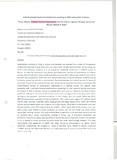Animal-related injuries to veterinians working in different sectors in kenya'

View/
Date
2013Author
Kirui, Gilbert
Thaiyah, Andrew Gitau Mulei
Matiku, Charles
Nguhiu-Mwangi, James
Mogoa, Mosoti G Eddy
Type
ArticleLanguage
enMetadata
Show full item recordAbstract
Veterinarians working or living in various environments are exposed to a variety of occupational
hazards and risks key among them injury on a daily basis. Despite animal related injuries being one
of the most common zoonoses, it is not among the reportable incidences in hospital records in
Kenya. In order for businesses and services benefiting from services of veterinarians to achieve
success, they should put in place health and safety measures that reduce work related injury risks in
line with risk assessments. There have been documented cases of injuries and even fatalities related
to injuries caused by animals to veterinarians, Para-veterinarians and animal owners. A survey of
veterinary professionals working in Kenya was carried out to document the factors associated with
animal-related injuries to veterinarians responding to a national survey. The subjects were
presented with a self-administered questionnaire requesting for their personal details, experience
and length of time in service. Factors associated with injury such as activity at the time of injury,
protective clothing in use and restraint facilities in use was investigated. For each injury, information
relating to management, reporting and effects to one's output was also asked. Eighty two (82%;
98/120) veterinarians responded to the questionnaire. The study results suggest that animal related
injuries (bites, wounds, scratches, pecks, tripping) were the major hazard (91%). Other self-inflicted
injuries such as needle pricks accounted for 9% of the injuries. Most (86%) of the injuries were selftreated
and the other 12% being treated at hospitals. While about 50% of the persons who have
been injured were willing to report incidences of injuries, only 5% had health and safety offices
within their working stations. The study revealed that though there is an awareness hazards and risk
to personal injury among veterinarians working in Kenya, use of protective equipment and
preventive measures is largely ignored. Some of the injuries such as dog bites; needle pricks present
a risk of spread of other zoonoses including rabies and other haemorrhagic diseases. The study
recommends that guidelines on health and safety should be entrenched in all sectors where
veterinary professionals are engaged in. Cases of personal injury related to animals should be
included among the reportable diseases and programmes put in place to reduce the risk of such
injuries occurring.
Publisher
University of Nairobi
